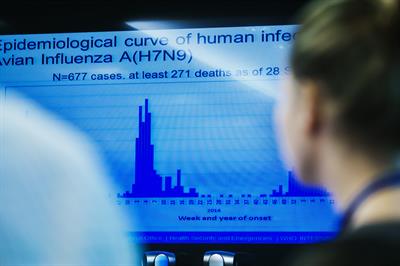 When the Chinese Center for Disease Control and Prevention confirmed the world’s first human cases of the avian influenza A(H7N9) virus in March 2013, the country sprang into action.
When the Chinese Center for Disease Control and Prevention confirmed the world’s first human cases of the avian influenza A(H7N9) virus in March 2013, the country sprang into action.Within 24 hours, China reported the outbreak to WHO, in line with the International Health Regulations, or IHR (2005). That same day, the Chinese Government shared genomic sequences of the virus with regional and global laboratories.
WHO also moved swiftly. The newly upgraded Emergency Operations Centre (EOC) for the Western Pacific Region immediately shifted focus from daily to round-the-clock monitoring and proactive response. Information and virus isolates were shared with a network of collaborating centres to facilitate joint risk assessment, preparedness planning, and research and development. Both the EOC and the network of collaborating centres had been strengthened under the Asia Pacific Strategy for Emerging Diseases and Public Health Emergencies (APSED III).
Thanks to the alert raised by China, the global community quickly came together to increase understanding and fight the shared risk. Once it was determined that the disease did not spread easily from person to person, steps were taken to limit the spread of disease among birds, which sharply reduced the number of people infected.
The speedy handling of H7N9 was the result of years of investment in surveillance and response, laboratories, zoonoses collaboration, risk communications and other key capacities. The outbreak of severe acute respiratory syndrome (SARS) in 2002 was a turning point in China’s commitment to health security.
Since that time, the country has gone from having limited technical expertise and resources to having capacities strong enough to help other countries. China now often assists other countries in responding to outbreaks and emergencies – such as the Ebola pandemic in West Africa and the 2015 earthquake in Nepal.
Across the Western Pacific Region, APSED III guides countries to make similar investments in health security. In doing so, countries can better protect their people – and those in neighbouring countries – during outbreaks and other public health events.
As for H7N9, sporadic cases continue to be detected. WHO continues to monitor closely H7N9 and other avian influenza viruses, because they have the potential to mutate and spread rapidly.
“One lesson is clear above all else: we must maintain a high level of vigilance and focus on preparedness efforts as we move forward, because regrettably this will not be our last battle with deadly viruses,” says Dr Shin Young-soo, WHO Regional Director for the Western Pacific.




